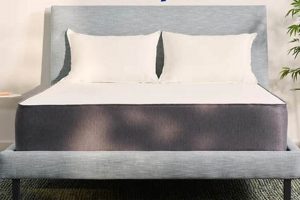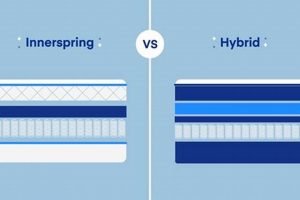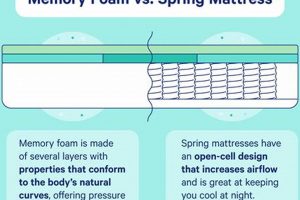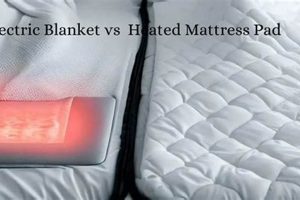The selection of a sleep surface is often dictated by personal preference, but individuals experiencing discomfort in the dorsal region require a more deliberate approach. Mattress selection, considering factors like surface compliance and support, can significantly impact spinal alignment and pressure distribution during rest. Understanding the properties of varying mattress types is crucial for mitigating existing pain and promoting restorative sleep.
Historically, firmer sleep surfaces were widely recommended. However, modern understanding acknowledges that a solution must balance support with conformity to the body’s natural curves. A sleep surface that is too unyielding may create pressure points, while one that offers insufficient support can lead to spinal misalignment. Proper support can lead to improved sleep quality and reduced musculoskeletal strain, both essential for managing and preventing discomfort.
The following sections will explore the characteristics of different mattress types, analyze the role of support and pressure relief, and provide guidance on selecting a sleep surface that optimizes spinal health and promotes restful sleep. Factors beyond mattress firmness, such as sleeping position and individual body weight, will also be considered to provide a holistic perspective on mattress selection.
Mattress Selection Guidance for Back Pain Mitigation
Selecting an appropriate mattress is a crucial step in managing and alleviating back pain. The following tips provide guidance for informed decision-making based on individual needs and spinal health considerations.
Tip 1: Prioritize Spinal Alignment: The primary objective is to maintain the natural curvature of the spine. A mattress should support the body’s weight evenly, preventing excessive sinking or arching in any particular area.
Tip 2: Consider Sleeping Position: Side sleepers typically benefit from a surface that allows the shoulders and hips to sink slightly, promoting spinal alignment. Back sleepers generally require a more supportive surface to prevent the lower back from collapsing. Stomach sleeping is often discouraged due to its tendency to exacerbate spinal strain, regardless of mattress type.
Tip 3: Evaluate Pressure Relief: Pressure points, particularly in the shoulders, hips, and lower back, can contribute to discomfort. A mattress that conforms to the body’s contours helps distribute weight and reduce localized pressure.
Tip 4: Account for Body Weight: Individuals with higher body weights may require a firmer mattress to ensure adequate support and prevent excessive sinking. Conversely, lighter individuals may find a plusher surface more comfortable and conforming.
Tip 5: Research Material Composition: Different mattress materials, such as memory foam, latex, and innerspring, offer varying levels of support, pressure relief, and temperature regulation. Research the properties of each material to determine the most suitable option.
Tip 6: Trial Before Purchase: Whenever possible, test the mattress in a similar sleeping position for an extended period. Many retailers offer trial periods, allowing for a more informed assessment of comfort and support.
Tip 7: Consider Adjustable Bases: An adjustable base can allow for elevation of the head and/or feet, potentially reducing spinal pressure and improving comfort for individuals with certain back conditions.
By carefully considering these factors, individuals can make a more informed choice when selecting a mattress, potentially leading to reduced pain, improved sleep quality, and enhanced overall well-being.
The following sections will delve into specific mattress types and their suitability for various back pain conditions, providing a more detailed analysis of the factors discussed above.
1. Support
Adequate support is a foundational element in managing back pain through mattress selection. The primary function of support is to maintain proper spinal alignment throughout the night, preventing undue stress on vertebral structures and surrounding muscles. A mattress lacking sufficient support allows the spine to sag, potentially exacerbating existing pain or contributing to the development of new musculoskeletal issues. Conversely, appropriate support ensures that the spine remains in a neutral position, reducing pressure on spinal discs and nerves.
The relationship between support and mattress firmness is complex. A surface described as “firm” does not automatically equate to optimal support. While a firm mattress may resist sinking, it may also fail to conform to the natural curves of the spine, particularly in the lumbar region. This can create pressure points and hinder proper alignment. Similarly, a “plush” mattress, while offering initial comfort, may lack the underlying support necessary to prevent spinal sagging, especially for individuals with higher body weights or those who prefer sleeping on their back. The ideal scenario involves a mattress that balances surface compliance with adequate internal structure to maintain spinal alignment, regardless of sleeping position.
Ultimately, the “correct” level of support depends on individual needs and preferences. A person with a higher body mass will generally require a firmer core to prevent sinking, while a lighter person might find sufficient support in a less dense mattress. The key is to assess how the mattress maintains spinal alignment while considering individual factors. In summary, support is not merely about firmness, but about the mattress’s ability to uphold the spine’s natural curvature, distributing weight evenly and preventing excessive pressure on any single point. The goal is to find a support system that adapts to the sleeper’s body shape and sleeping position, promoting restful and pain-free sleep.
2. Alignment
Spinal alignment is paramount in mitigating back discomfort, and the choice between mattress firmness levels directly influences this critical factor. A mattress should facilitate the natural curvature of the spine, minimizing stress and promoting restful sleep. When considering surfaces, the relationship between support, conformity, and body positioning must be thoroughly evaluated.
- Neutral Spine Position
A neutral spine position maintains the natural curves of the cervical, thoracic, and lumbar regions. Mattresses that adequately support these curves prevent excessive bending or straightening, reducing strain on spinal structures. A surface that is excessively unyielding might fail to conform to these curves, while a surface with insufficient support can lead to sagging and misalignment.
- Pelvic Alignment
The pelvis serves as the foundation for the spine, and its alignment is essential for maintaining proper posture. A mattress that allows the pelvis to tilt excessively forward or backward can disrupt the natural curvature of the lumbar spine. Proper support beneath the pelvis is vital to prevent rotation and maintain a balanced spinal position, regardless of the sleeper’s position.
- Shoulder Accommodation
In side-sleeping positions, the mattress must accommodate the width of the shoulders to prevent spinal bending. A surface that is too firm will push the shoulder upwards, leading to spinal misalignment. Conversely, a surface that is too soft will allow the shoulder to sink excessively, causing a similar misalignment. The ideal surface provides sufficient give to allow the shoulder to sink slightly, maintaining a horizontal spinal orientation.
- Lumbar Support
The lumbar region is particularly vulnerable to misalignment due to its natural inward curve. Mattresses should provide targeted support to prevent the lumbar spine from collapsing or arching excessively. Insufficient lumbar support can lead to muscle strain and disc compression. Some mattresses incorporate specialized lumbar support features to address this critical need.
In conclusion, mattress selection hinges on its ability to promote and maintain proper spinal alignment. Considering the facets previously discussed, individuals should evaluate how varying firmness levels interact with their body type and sleeping position to optimize spinal health and reduce back pain. The goal is to find a sleep surface that allows for natural spinal curvature, minimizing strain and supporting restful sleep.
3. Pressure Relief
Effective pressure relief is a critical consideration when selecting a mattress for individuals experiencing back pain. The degree to which a mattress can minimize concentrated pressure on bony prominences and sensitive areas significantly impacts comfort and can influence the severity of pain symptoms. A mattress that fails to provide adequate pressure relief can exacerbate existing pain and disrupt sleep quality. Understanding the mechanisms and nuances of pressure relief is essential for making an informed choice when evaluating mattress firmness levels.
- Weight Distribution
The primary goal of pressure relief is to distribute body weight evenly across the sleep surface. Concentration of weight on specific areas, such as the hips, shoulders, and heels, can lead to localized discomfort and restricted blood flow. Mattresses designed for pressure relief conform to the body’s contours, increasing the surface area in contact with the mattress and reducing the pressure per unit area. This redistribution of weight minimizes stress on individual joints and tissues, promoting comfort and reducing pain.
- Conformity and Sinkage
The ability of a mattress to conform to the body’s shape is a key determinant of its pressure-relieving capabilities. “Plush” mattresses typically offer greater initial conformity due to their softer surface layers. This allows bony prominences to sink into the mattress, reducing pressure on these areas. However, excessive sinkage can lead to spinal misalignment, negating the benefits of pressure relief. “Firm” mattresses, while providing greater support, may offer less initial conformity, potentially creating pressure points. The ideal mattress strikes a balance between conformity and support, allowing for adequate pressure relief without compromising spinal alignment.
- Material Properties
The materials used in mattress construction significantly impact pressure relief. Memory foam, for example, is known for its ability to conform to the body’s shape and distribute weight evenly. Latex also offers good pressure relief, although its response is generally more resilient than memory foam. Innerspring mattresses, particularly those with individually wrapped coils, can provide targeted support and pressure relief by contouring to the body’s shape. Hybrid mattresses, which combine different materials, aim to leverage the benefits of each, offering a balance of support and pressure relief.
- Microclimate Regulation
While not directly related to pressure distribution, temperature regulation can indirectly influence pressure relief. Overheating can increase discomfort and muscle tension, exacerbating pressure points. Mattresses that promote airflow and dissipate heat can help maintain a comfortable sleeping temperature, reducing the perception of pressure and enhancing overall comfort. Materials such as open-cell foam and breathable fabrics can improve microclimate regulation.
The effectiveness of pressure relief is intertwined with mattress firmness. A plusher surface might initially seem more comfortable, but it’s crucial to evaluate whether it compromises spinal alignment. A firmer surface might offer better support, but could lead to pressure points if it lacks sufficient conformity. Ultimately, the optimal choice balances pressure relief with adequate support to maintain spinal health and minimize back pain. Individual preferences and sleeping positions further influence the ideal combination of firmness and material properties.
4. Sleeping Position
Sleeping position significantly interacts with mattress firmness to influence back pain. The relationship is causal: posture adopted during sleep, in conjunction with mattress characteristics, determines the degree of spinal alignment and pressure distribution. Consider a side sleeper. A mattress that is too firm does not allow the shoulder and hip to sink sufficiently, resulting in spinal curvature and potential discomfort. Conversely, a mattress that is too soft results in excessive sinkage, similarly misaligning the spine. The ideal scenario provides a surface that yields to accommodate these contours while maintaining overall support. This contrasts sharply with the needs of a back sleeper, who typically benefits from a more rigid surface to prevent the pelvis from sinking, thereby averting lower back strain. Therefore, sleeping position dictates the necessary balance between compliance and support.
The importance of sleeping position as a component of mattress selection is exemplified by individuals with specific spinal conditions. For instance, a person with scoliosis may require a mattress that accommodates their spinal curvature, often necessitating a custom or highly adaptable sleep surface. Similarly, individuals recovering from spinal surgery may have specific positioning requirements prescribed by their physician, which directly influence mattress selection. Failing to account for sleeping position can negate the benefits of even the most expensive or highly-rated mattress, leading to persistent pain and poor sleep quality. Retail settings often demonstrate this, where individuals select mattresses based on initial comfort without considering how their preferred sleeping position interacts with the surface over extended periods.
The implications of understanding the interplay between sleeping position and mattress firmness are practical. It necessitates a more holistic approach to mattress selection, emphasizing assessment of preferred sleep posture. This understanding should inform retail practices, guiding consumers toward more appropriate choices. Clinically, this awareness can improve therapeutic interventions for back pain, incorporating mattress recommendations as part of a comprehensive treatment plan. Ultimately, recognizing sleeping position as a crucial determinant in the plush versus firm debate improves the likelihood of selecting a mattress that promotes spinal health and provides restful sleep, thereby minimizing back pain.
5. Body Weight
Individual body weight is a critical determinant in mattress selection, particularly for those seeking relief from back pain. The interaction between body mass and mattress firmness influences spinal alignment, pressure distribution, and overall sleep comfort. Understanding this relationship is essential for selecting a sleep surface that provides adequate support and minimizes discomfort.
- Support Requirements
Individuals with higher body weights require mattresses that offer greater support to prevent excessive sinking and maintain spinal alignment. Mattresses lacking sufficient support can allow the spine to sag, leading to increased pressure on spinal discs and surrounding muscles. Conversely, individuals with lower body weights may find firmer mattresses uncomfortable due to insufficient contouring and pressure relief. Therefore, support requirements are directly proportional to body weight, necessitating careful consideration of mattress firmness and construction.
- Pressure Distribution
Body weight affects the distribution of pressure across the sleep surface. Higher body weights concentrate pressure on specific areas, such as the hips and shoulders, potentially leading to discomfort and restricted blood flow. Mattresses designed for heavier individuals often incorporate features that enhance pressure distribution, such as thicker comfort layers and zoned support systems. These features help to minimize localized pressure and promote more comfortable sleep. In contrast, lighter individuals may not require such extensive pressure relief features and may find that a softer mattress conforms sufficiently to their body shape.
- Mattress Durability
Body weight influences mattress durability and lifespan. Mattresses subjected to higher body weights experience greater stress and compression, potentially leading to premature sagging and loss of support. Selecting a mattress constructed with durable materials and robust support systems is crucial for ensuring longevity and maintaining optimal performance over time. Heavier individuals should consider mattresses with reinforced edges and high-density core materials to enhance durability and prevent premature wear. Lighter individuals may have a wider range of options available, as the impact on mattress durability is less pronounced.
- Material Selection
Body weight should inform material selection when choosing a mattress. Memory foam, for example, offers excellent contouring and pressure relief but may not provide sufficient support for heavier individuals, particularly in the absence of a dense support core. Latex, with its resilient and supportive properties, can be a better option for those requiring greater support. Innerspring mattresses, particularly those with individually wrapped coils, can provide targeted support and contouring, making them suitable for a range of body weights. Hybrid mattresses, combining different materials, offer versatility and can be tailored to specific body weight requirements.
In summary, body weight plays a central role in determining the ideal mattress firmness and construction for individuals seeking relief from back pain. Understanding the relationship between body mass and mattress characteristics, including support requirements, pressure distribution, mattress durability, and material selection, is essential for making an informed choice that promotes spinal health and ensures restful sleep. A mattress that fails to account for body weight may exacerbate existing pain or contribute to the development of new musculoskeletal issues.
6. Material Type
Material type is a foundational determinant of both mattress firmness and its impact on back pain. The constituent materials directly influence a mattress’s capacity to provide support, pressure relief, and spinal alignment, all of which are critical factors in mitigating dorsal discomfort. For example, a mattress constructed primarily of low-density polyurethane foam will invariably offer a plusher feel but may lack the structural integrity to support the spine adequately, particularly for individuals with higher body weights or those who sleep on their backs. This deficiency can lead to spinal misalignment and exacerbate existing pain. Conversely, a mattress composed of high-density latex or containing a robust innerspring system will generally exhibit a firmer profile, offering greater support but potentially compromising pressure relief at contact points. The selection of materials, therefore, is not arbitrary but directly causative of the mattress’s performance in addressing back pain.
The importance of material type is further underscored by the diverse properties of commonly used mattress components. Memory foam, for instance, is prized for its viscoelastic properties, allowing it to conform closely to the body’s contours and distribute weight evenly, thereby reducing pressure points. This can be particularly beneficial for side sleepers or individuals with conditions such as arthritis. However, memory foam’s inherent density can also trap heat, potentially causing discomfort for some users. Latex, available in both natural and synthetic forms, offers a more responsive feel than memory foam and is often lauded for its breathability and durability. Innerspring systems, characterized by their coiled construction, provide a firmer, more resilient feel, though their ability to conform to the body’s contours is generally less pronounced. Hybrid mattresses, which combine elements of different material types, represent an attempt to optimize both support and pressure relief, tailoring the sleep surface to a broader range of needs. As an illustration, hybrid mattresses that combines pocketed coil and memory foam gives individual comfort.
In summary, the selection of mattress materials constitutes a critical decision point in managing back pain. While firmness is a readily apparent characteristic, it is the underlying material composition that ultimately dictates the mattress’s ability to provide effective support, pressure relief, and spinal alignment. Challenges remain in balancing the often-competing properties of different materials, and the ideal choice will invariably depend on individual factors such as body weight, sleeping position, and specific pain conditions. Understanding the nuanced relationship between material type and mattress performance is, therefore, of paramount importance in selecting a sleep surface that promotes spinal health and minimizes back pain.
Frequently Asked Questions
The following questions address common concerns regarding the selection of mattress firmness in relation to back discomfort, providing clarity on factors influencing optimal sleep surface choice.
Question 1: Is a firmer mattress always better for back pain?
No. While firmer mattresses were traditionally recommended, current understanding emphasizes the importance of spinal alignment and pressure relief. An excessively firm mattress may not conform to the body’s natural curves, leading to pressure points and discomfort. The ideal mattress balances support with contouring to maintain proper spinal alignment.
Question 2: How does sleeping position influence mattress firmness selection?
Sleeping position is a significant factor. Side sleepers often benefit from a mattress that allows the shoulders and hips to sink slightly, promoting spinal alignment. Back sleepers generally require a more supportive surface to prevent the lower back from collapsing. Stomach sleeping is often discouraged regardless of mattress type.
Question 3: Does body weight affect the ideal mattress firmness?
Yes. Individuals with higher body weights typically require a firmer mattress to ensure adequate support and prevent excessive sinking. Lighter individuals may find a plusher surface more comfortable and conforming.
Question 4: What mattress materials are most suitable for back pain relief?
Various materials can be beneficial. Memory foam conforms to the body’s shape, distributing weight and reducing pressure points. Latex offers a balance of support and responsiveness. Innerspring mattresses, especially those with individually wrapped coils, can provide targeted support. Hybrid mattresses combine different materials to optimize both support and pressure relief.
Question 5: How can one assess mattress firmness prior to purchase?
Whenever possible, test the mattress in a preferred sleeping position for an extended period. Many retailers offer trial periods, allowing for a more informed assessment of comfort and support. Consider the retailer’s return policy before committing to a purchase.
Question 6: Are adjustable bases beneficial for individuals with back pain?
Adjustable bases can allow for elevation of the head and/or feet, potentially reducing spinal pressure and improving comfort for individuals with certain back conditions. They can be particularly helpful for those with conditions such as spinal stenosis or degenerative disc disease.
In summary, the selection of a mattress should be tailored to individual needs, considering factors such as spinal alignment, sleeping position, body weight, and material properties. No single firmness level is universally optimal for all individuals experiencing back pain.
The following section will provide a comprehensive guide to various mattress types and their suitability for different back pain conditions, offering further insights into informed mattress selection.
Plush vs Firm Mattress for Back Pain
The preceding analysis underscores the complexity inherent in selecting a sleep surface for individuals experiencing dorsal discomfort. Direct correlation between a specific firmness level and universal pain reduction is not demonstrable. Rather, the efficacy of a given mattress hinges on its capacity to facilitate spinal alignment, distribute pressure effectively, and accommodate individual factors such as sleeping position and body weight. A mattress that fails to account for these elements may exacerbate existing conditions, negating potential therapeutic benefits.
Ultimately, the determination of optimal mattress firmness represents a personalized endeavor, requiring careful consideration of individual needs and preferences. Future research should focus on refining diagnostic tools and developing targeted interventions to optimize mattress selection for specific back pain conditions. Prioritizing informed decision-making and comprehensive assessment is paramount in promoting spinal health and maximizing the restorative benefits of sleep.


![Firm vs Plush Mattress: Find Your Best Sleep [Guide] Organic & Natural Mattress Buyer’s Guide: Non-Toxic Sleep Solutions Firm vs Plush Mattress: Find Your Best Sleep [Guide] | Organic & Natural Mattress Buyer’s Guide: Non-Toxic Sleep Solutions](https://mattressworldpa.com/wp-content/uploads/2025/07/th-1112-300x200.jpg)




